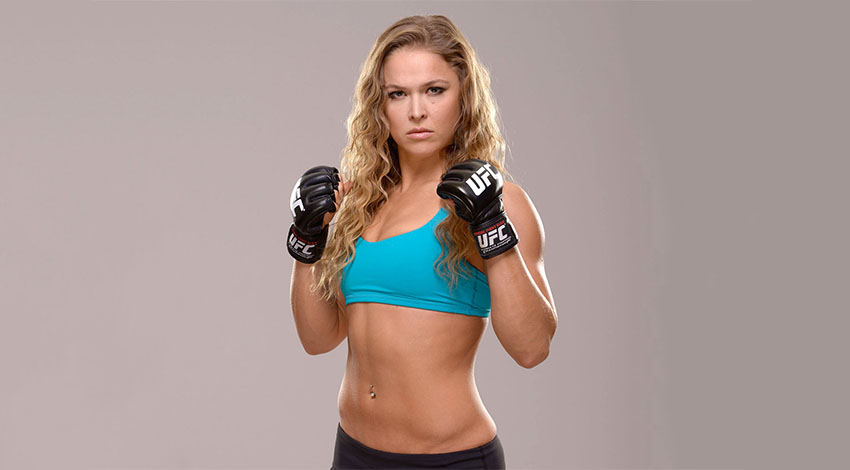Ronda Rousey, affectionately referred to as “Rowdy Ronda” or “The Arm Collector,” stands as an iconic figure in the mixed martial arts (MMA) scene. An American MMA pioneer, she earned her reputation as a champion in both Strikeforce and later in the UFC. Rousey’s unmatched prowess in the ring earned her a distinctive title as one of the premier fighters across multiple weight categories. Holding a distinguished position, she sits at the pinnacle of the female athlete rankings within the “super bantamweight” category. In a new phase of her illustrious career, Ronda has made a mark in professional wrestling, with her current engagement in the WWE. Within the MMA arena, the topic of steroid use is recurrent and controversial.
So, the question that often arises is, did Ronda Rousey ever resort to using steroids?
Ronda Rousey’s Early Life and Background
Ronda’s journey began in February 1987 when she was welcomed into the Rousey clan. The diversity in her lineage is evident as her parents heralded from varied backgrounds, giving Ronda Venezuelan, African, English, and Polish roots. A notable part of her lineage is her mother, a seasoned judoka.
She wasn’t just a sibling but the youngest among three. Her elder sisters, Maria Burns-Ortiz and Jennifer, were always by her side, and later on, the family was graced by the presence of another sister, Julia DeMars.
Growing up, Ronda faced significant challenges, both personal and health-related. One of these challenges was a speech disorder. Medically diagnosed with apraxia, this motor disorder, stemming from damage to the posterior parietal cortex, affected her speech, movement, and spatial reasoning. This neurological issue was attributed to complications during childbirth, specifically from the umbilical cord loop. To seek the best care for their daughter, the Rousey family relocated to North Dakota, intending to consult a specialized speech therapist for prolonged treatment.
Life dealt another blow when Ronda lost her father at the tender age of eight. After suffering grave injuries from a dogsled accident, the emotional pain became unbearable for him, leading him to take his own life. Later on, her mother found solace in the arms of an aerospace engineer who played a vital role in the upbringing of the children.
“Rowdy,” Ronda’s well-known moniker, is a homage to the late pro wrestler, Roddy Piper (Roderick George Toombs), who passed away from cardiopulmonary arrest due to hypertension in 2015.
In her budding years, Ronda showcased her athletic talents and went on to clinch the title of the world champion in judo among juniors, setting the stage for her legendary career.
Ronda Rousey in MMA
Ronda Rousey’s illustrious professional journey took flight at an impressively young age. Notably, during her clash with Hayden Muñoz, she set a precedent by securing a win with an armbar just 23 seconds in. Rousey’s reputation soared due to her ability to swiftly subdue opponents, often wrapping up bouts in an average of 3 to 4 minutes.
Sports analysts often commend her adept integration of wrestling techniques into her fights. Her mastery over the armbar, a skill she honed during her teenage years, became her signature move. This prowess enabled her to triumph in nine of her twelve MMA bouts as she progressed in her career.
A monumental moment in Rousey’s career came in 2015, in Melbourne, Australia. Here, the UFC bantamweight champion title was on the line against Holly Holm, an opponent renowned for her undefeated streak. The betting odds heavily favored Rousey. With her trademark strategy of incrementally ramping up the pressure, Rousey aimed to claim victory in the first round. However, Holm’s boxing acumen and remarkable resilience countered Rousey’s advances. The match reached a critical juncture in the second round when Holm landed a fierce kick to Rousey’s jaw, marking a turning point in this grueling contest. Although Rousey attempted a comeback, a swift high kick from Holm led to her first career knockout. The medical scans post-fight revealed no major injuries, but Rousey’s return to the octagon remained uncertain. It wasn’t until the end of 2016 that she faced Amanda Nunes in another title bout, which she unfortunately lost.
Venturing into Hollywood
2013 saw Rousey transition to the silver screen. Sylvester Stallone tapped her for a role in “The Expendables 3,” where she portrayed Luna, an ex-bouncer turned mercenary. This stint paved the way for her participation in the seventh episode of the “Fast and the Furious” series, sharing the limelight with stars like Dwayne Johnson and Vin Diesel. Here, she took on the role of a security head. Later in 2016, Rousey showcased her acting chops in the “Road House” remake, a nod to the classic that starred Patrick Swayze.
Ronda’s Foray into Wrestling
By September 2017, reports from The Sun indicated Rousey’s shift from MMA to the wrestling arena. Her wrestling debut unfolded at the WWE Survivor series in November of the same year. Competing in a 4×4 match format, Rousey teamed up with fellow MMA fighters Shayna Baszler, Jessamyn Duke, and Marina Shafir, collectively known as the Horsewomen. Their opponents, also labeled the Four Horsewomen, comprised champions Charlotte Flair, Sasha Banks, Bayley, and Becky Lynch.
The Personal Facet of Rousey’s Life
While speculations about Rousey’s personal life frequently surfaced, it wasn’t until the fall of 2015 that her romantic involvement with UFC heavyweight fighter Travis Browne became public knowledge. The couple, unabashed about their blossoming relationship, tied the knot in 2017 amidst close family and friends.
On the social media front, Rousey maintains an active Instagram profile (@rondarouse), sharing glimpses of her pets, intimate moments with her husband, and a plethora of other candid shots. Moreover, various magazines frequently feature her, celebrating both her athleticism and her charisma.
Ronda Rousey Amidst Steroid Controversies
In the sporting world of 2015, two influential female athletes found themselves amidst a heated argument involving steroid allegations. Ronda Rousey didn’t hold back when she aimed disparaging remarks at Cris Cyborg, insinuating that Cris had an over-reliance on steroids rather than honing her fighting techniques. Ronda’s direct words were, “She can compete at 145 pumped full of steroids, or she can make the weight like the rest of us without them.”
Cris promptly addressed Ronda’s claims, tweeting, “The media is no place for baseless accusations. My attorney will be in touch.” What began as a war of words escalated into a significant conflict, but, with time, it seemed to subside quietly.
However, Ronda herself wasn’t immune to the rumor mill. In 2016, an individual going by the name Mr. White made a series of bizarre and unsubstantiated allegations:
- Ronda is actually a man posing as a woman to gain an unfair advantage in the UFC.
- Ronda was secretly involved with Alex Rodriguez.
- There exists an intimate tape of Rousey and fighter John Jones, which Mr. White claimed to possess. Ronda supposedly retaliated with threats against him if the tape wasn’t surrendered.
- Her biological father was purported to be Ron Jeremy, suggesting her real name is Ronald Rousey.
- She was a frequent user of steroids.
Surprisingly, a temporary restraining order was secured against Ronda, indicating she was to maintain a certain distance from Mr. White. This order was provisionally granted without a full court hearing or considering the defendant’s side, pending a more formal evaluation. The ultimate outcome of this situation remains unclear.
It’s worth noting that there’s no concrete evidence supporting claims that Ronda consumed performance-enhancing drugs like Anavar, Sustanon 250, or methandienone. In today’s era, any assertions about such matters must be handled with care and skepticism.
Steroid before and after cases might interest you.

